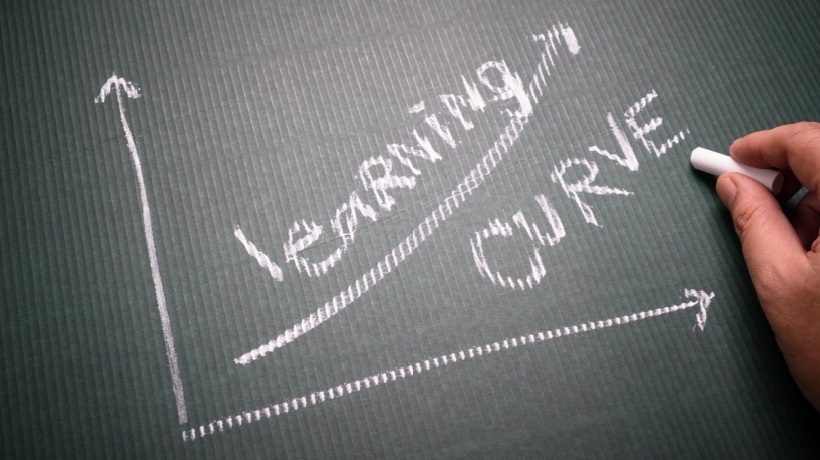Mastering The Learning Curve
In the always-changing and fast-paced business world, employees who are fast learners with the ability to acquire, retain, and apply new knowledge quickly are the key to a business's success. One of the most critical and yet most misunderstood models of the Learning and Development process is the learning curve. For Learning and Development (L&D) professionals, it is crucial to know the learning curve pattern to be able to come up with the best training programs, improve resource allocation, etc., which will, in the end, lead to the organization's productivity growth.
This article delves into the learning curve concept, its types, applications, and its strategic significance in corporate L&D. It further elaborates on the utilization of those aspects in the real business world and the best practices and data points to help companies bring the most out of the concept.
In this article, you'll find...
- What Is The Learning Curve?
- Types Of Learning Curves
- Why The Learning Curve Matters In Corporate L&D
- Strategies To Improve The Learning Curve In Training Programs
- Real-World Applications Of The Learning Curve In L&D
- Key Metrics To Monitor Learning Curve Efficiency
What Is The Learning Curve?
The learning curve is a pictorial representation of the increase in a person's skill acquisition over a period of time. It usually indicates that success in the process of learning increases with repetitions or exposure that is experience-related, in the sense that with each additional repetition or exposure, the time, effort, or cost that goes to waste diminishes drastically.
The concept of learning by repetition, introduced by Hermann Ebbinghaus and used to test human memory and recall of the late nineteenth century, has since seen an unprecedented metamorphosis into the pivotal force behind various human capital development activities such as training and talent management as well as the skillful conduct of the operations. In the context of the corporate world, the learning curve positively reflects the cost factor, time required for employees to become accustomed, and the final result of increased productivity.
Types Of Learning Curves
Knowing about the various learning curve types is essential for L&D professionals as it will help them to better judge employee progress and make the necessary adjustments to their training interventions:
Positive Accelerating Learning Curve
The movement starts slow and then, in the end, reaches a faster pace. It is a situation where it is necessary to acquire a foundation first and then the learning is more effective. An example can be the learning of advanced software coding languages. Progress starts slowly but accelerates over time. Common in complex tasks that require foundational understanding before efficiency increases.
- Example
Learning advanced software coding languages.
Negative Accelerating Learning Curve
Quick learning is followed by a decrease as the learner gets close to mastery. This is the situation where it is easy to get the basics of a few principles but difficult to perfect them. An example of this would be learning how to use a basic CRM system. Quick learning is followed by a decrease as the learner gets close to mastery.
Linear Learning Curve
The rate of learning is constant throughout the period of time. It is very rare in real-life situations yet very efficient for repetitive tasks. An example is the repetitive patterns of data entry work.
Plateau Learning Curve
The person learns fast at first but becomes slower over a period of time. It tells you that you should switch the teaching technique or motivate students to do better for better learning results. A typical situation might be sales training where the sketched conversation worked well until the prospects' objections came up.
Why The Learning Curve Matters In Corporate L&D
1. Training ROI And Cost Optimization
The learning curve is a major factor that not only delimits the budget for educational courses but also defines cost-saving measures. A steep curve (quick learning) means less time and more productivity; in other words, an organization will be able to recover the investment in the short run. According to the Association for Talent Development (ATD), the yearly average training cost per employee is around $1,252 for each organization. If the learning curve is not routed well, it may lead to a loss of a lot of money even with such substantial training investments.
It has been observed that the L&D managers who design their training around course content and use multiple channels for skills reinforcement can smooth the curve and condense the time it takes for a trainee to become competent. Thus, they can kill two birds with one stone, reducing the time and the investments to the extent they get both the ROI and the training they want.
2. Onboarding And Ramp-Up Time
In organizations where the evolution of the workforce is fast-paced, onboarding effectiveness has a strategic role in the company's operations. A study from Glassdoor demonstrates that effective onboarding boosts the retention of employees by 82% and their productivity by 70%. Mapping the learning curve elucidates the transition time of new employees to be fully competent, thus leading to better workflow management by letting managers know when to expect the employee's involvement and at what capacity.
3. Performance Evaluation And Continuous Improvement
The learning curve serves as a reliable source of feedback on employee improvement, efficiency, and work speed. By observing how staff members acquire knowledge and the time it takes them to master it, the training and development department can decide which learning plan should be modified or cut, thus leading to a more personalized and engaging way for employees to acquire knowledge. This method is effective in that it allows for the training to have a positive impact as well as to be aligned with what the business has set as outcomes.
Strategies To Improve The Learning Curve In Training Programs
1. Microlearning For Focused Retention
Microlearning is designed to make complex information simple for the mind by presenting it in smaller, manageable modules, which is faster to absorb and at the same time retained longer. This model is based on the compelling argument of the Ebbinghaus forgetting curve that 70% of acquired knowledge will be lost within 24 hours if there is no rehearsal. The learning modules of microlearning are a direct counter in as much they supply the needed information at the right time, and they make the learner to suffer less from cognitive overload so they smooth the learning curve as well.
2. Scenario-Based Learning
When trainers employ real-life scenarios and problem-solving activities, it allows learners to imagine the stepping stones of theory functioning in practice. In a statement by Training Industry, learners were 75% more likely to remember the material if it consisted of a context-based lesson. This particular method helps the learning curve as it propels the learners to the practice field and makes it convenient to learn through practice.
3. Adaptive Learning Technologies
AI-driven adaptive learning platforms change the difficulty level of the activities and in what way they should be done based on the learner's performance and preferences. Essentially the technology causes the platform to shape each individual trajectory into the one most relevant to the learner in that it neither makes it too easy nor too difficult to learn.
4. Feedback Loops And Continuous Assessment
Frequent low-stakes quizzes and coaching sessions have been found to achieve the objective of keeping the learner engaged, preventing reversion back along the curve and decreasing dropouts that result from frustration. The learner therefore always has the awareness and the certainty of the level they have attained since the learning is a continuous engagement that keeps giving them feedback on their progress. Everyone can decide for themselves what they want or are able to afford financially, as well as how important or urgent further training is.
5. Gamification And Motivation
By adding gamified features such as badges, leaderboards, and rewards, it becomes easier to tap into intrinsic motivation. According to a Gallup report, motivated employees are 21% more productive. The learning curve is directly affected by motivation, which further determines how quickly and efficiently learners learn.
Real-World Applications Of The Learning Curve In L&D
The following are the names of some industry leaders who have successfully used the learning curve to improve their training results:
- Amazon collects comprehensive data on the learning curves of their warehouse staff to streamline the onboarding process and minimize mistakes.
- Microsoft has embedded principles of adaptive learning into their onboarding platforms, which resulted in the reduction of the training time needed by 30%.
- General Electric (GE) has adopted learning curve models in the technical and leadership training programs to project an employee's readiness for a key role.
Key Metrics To Monitor Learning Curve Efficiency
For making their training efforts more efficient by using the learning curve, L&D professionals have to monitor the following:
- Time to competency
The time a learner needs to reach the level of proficiency. - Knowledge retention rates
The learning that takes place and is retained after long periods of no practice. - Task completion time
The time it takes from the onset of the task by the learner to its completion. - Error rates
A decline in errors as a result of subsequent repetitions. - Training ROI
Cost versus productivity impact over time.
Conclusion
In the face of ever-changing technology, markets, and business, the adage of "learn or die" cannot be more relevant. Knowledge is not only an asset in this era, but it is actually the best asset. Understanding the learning curve and its role in the process of professional development and lifelong learning is the only key to progress. It not only helps in optimizing performance and saving time but also in creating conditions that can withstand any adverse situations or crises that may arise in the future. Through hard work and a mindset of unceasing learning you can attain and build up a team of versatile and resilient associates capable of handling complex work situations.









